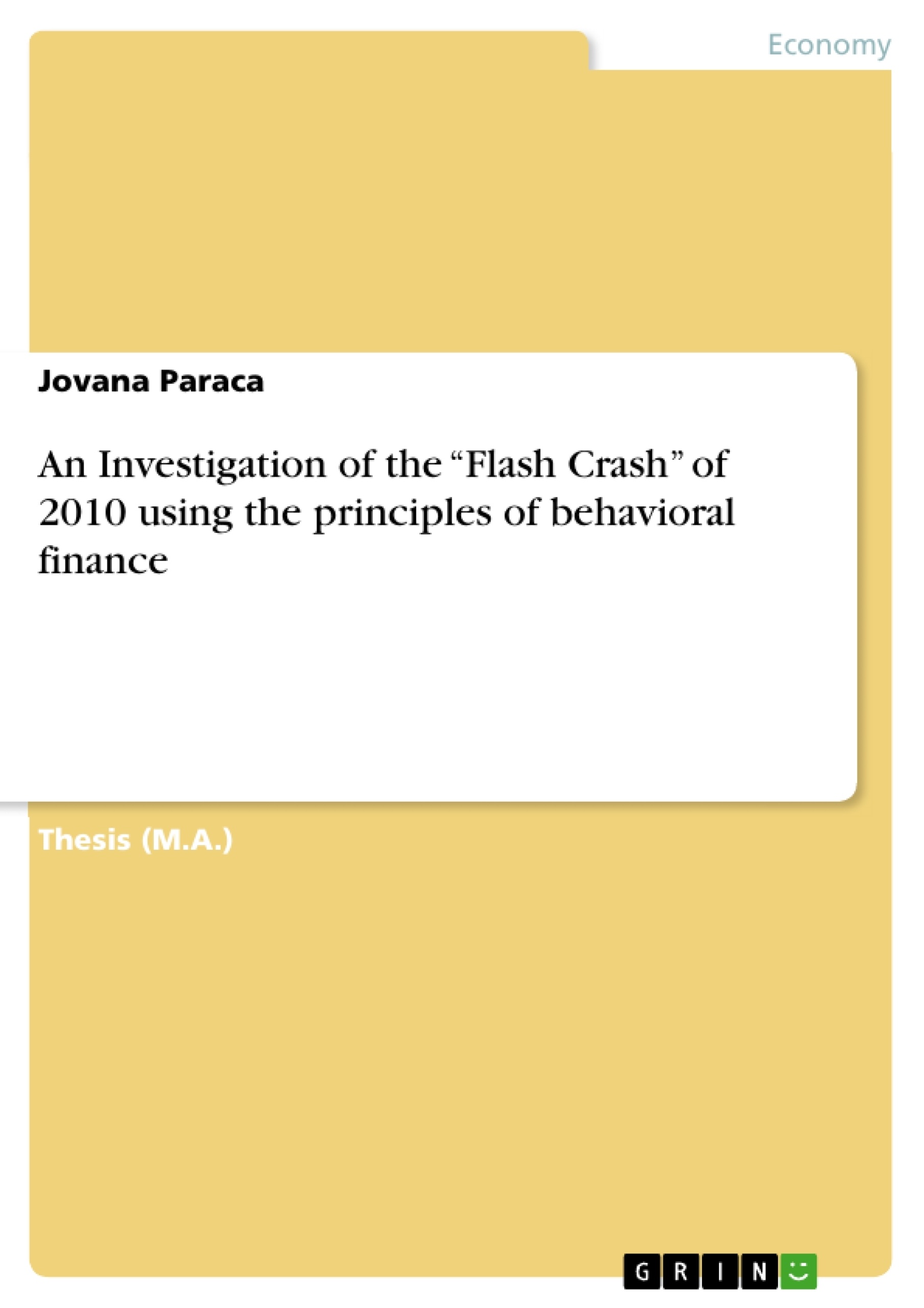In every market there are some trading or buying anomalies that cannot be explained by financial instruments and theories alone. For this reason the field of behavioral finance was developed. As investors are humans, they sometimes act in according to their instinct rather than strict financial rules, principals or inputs. There have been many events in the last century that do not have a clear financial explanation but rather seem more possibly explained by psychological factors. One of the most recent events that has been witness to this financial anomaly is the “Flash Crash of 2010”. This research will look into the event as well as examine how behavioral finance theories can be used to create a rational explanation to this seemingly irrational event.
Inhaltsverzeichnis (Table of Contents)
- ABSTRACT
- ACKNOWLEDGEMENT
- LIST OF ABBREVIATIONS
- CHAPTER 1: INTRODUCTION
- STRUCTURE OF THE PAPER
- CHAPTER 2: LITERATURE REVIEW
- BEHAVIORAL FINANCE
- MAJOR LITERATURE
- STATUS QUO BIAS
- TRANSITORY COMPONENTS
- UTILITY HYPOTHESIS IS QUESTIONED
- GENDER AS A FACTOR IN DECISION MAKING
- BEHAVIOR OF INDIVIDUAL INVESTORS
- FEEDBACK THEORIES
- TWO TYPES OF INVESTORS: SMART MONEY VS. ORDINARY INVESTORS
- THE NEED FOR BEHAVIORAL FINANCE
- EVENTS LEADING UP TO THE CRASH
- FLASH CRASH 2010: A BRIEF SUMMARY
- NET RESULT OF FLASH CRASH
- CHAPTER 3: RESEARCH QUESTION AND FRAMEWORK
- RESEARCH QUESTIONS
- QUESTION 1: WHICH THEORIES EXPLAIN THE FLASH CRASH?
- QUESTION 2: WHICH COMPANIES?
- QUESTION 3: CIRCUITBREAKERS
- CHAPTER 4: RESEARCH METHODOLOGY
- OBJECTIVE OF THE RESEARCH
- RESEARCH PROTOCOL
- HOW RESEARCH QUESTIONS WERE ANSWERED?
- STRENGTH OF ASSOCIATION
- MATERIALS USED
- HOW MATERIALS WERE PREPARED
- DATA COLLECTION
- TYPES OF DATA
- JUSTIFICATION OF STUDY'S DESIGN
- ESTABLISHING RIGOR
Zielsetzung und Themenschwerpunkte (Objectives and Key Themes)
This dissertation explores the 2010 "Flash Crash" through the lens of behavioral finance. Its goal is to provide a rational explanation for this seemingly irrational event by applying behavioral finance theories.
- The role of behavioral finance in understanding market anomalies.
- The impact of psychological factors on investor decision-making.
- Analysis of the "Flash Crash" of 2010 and its contributing factors.
- Application of behavioral finance theories to explain the event.
- The implications of the "Flash Crash" for market regulation and investor behavior.
Zusammenfassung der Kapitel (Chapter Summaries)
Chapter 1 provides an introduction to the research, outlining the structure of the dissertation and its focus on the "Flash Crash" of 2010. Chapter 2 offers a review of relevant literature in behavioral finance, examining various theories and their application to understanding market events. It discusses the need for behavioral finance to address inconsistencies in traditional financial models, particularly in light of real-world events like the "Flash Crash." Chapter 3 delves into the research questions and framework, outlining the specific inquiries to be explored in the study. The questions focus on identifying the behavioral finance theories explaining the "Flash Crash," the companies involved, and the role of circuit breakers in the event. Finally, Chapter 4 presents the research methodology, detailing the objective, protocol, and data collection techniques used to answer the research questions.
Schlüsselwörter (Keywords)
The central keywords and focus topics of this work include: behavioral finance, financial anomalies, "Flash Crash" of 2010, investor psychology, market regulation, circuit breakers, and irrational market behavior.
- Quote paper
- Jovana Paraca (Author), 2013, An Investigation of the “Flash Crash” of 2010 using the principles of behavioral finance, Munich, GRIN Verlag, https://www.grin.com/document/270372



